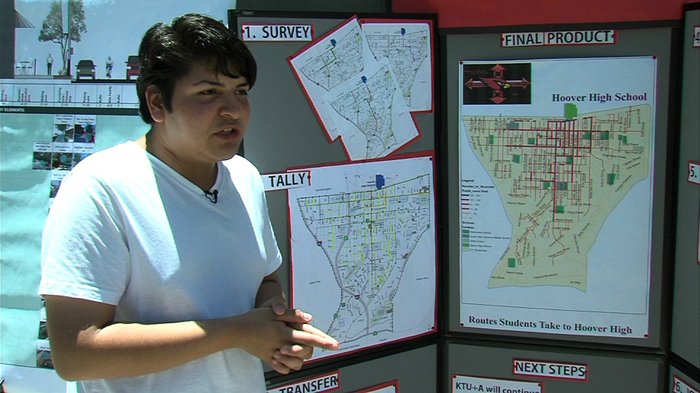What if you could tell city planners exactly what you would like to see fixed on the streets you walk and drive on every day? A project in City Heights is giving residents the opportunity to do just that. And KPBS education reporter Kyla Calvert takes us to a classroom where high school students are building some of the maps that will help reshape their neighborhood. | Video Credit: Katie Euphrat, KPBS
One recent morning, Bryan Voeltner was leading his students through a few of the steps it will take to turn hundreds of student surveys into a single map. Students were trying to iron out the glitches they came across trying to pair up dozens of files.
Every 10 minutes, Voeltner would call their attention back to the large screen at front of the room where he could give them a step-by-step demonstration on a projected image of his computer screen of where to save each file and where to find the folders they were looking for.
This is Voeltner’s fourth year teaching the Geographic Information Systems, or GIS, class. It is one of the electives that’s part of Hoover High School’s Information Technology Academy.
“We had been wanting to get a new career path opportunity for the students and we had been hearing that GIS was a growing field,” he said.
Joe Punsalan is already part of that growing field.
“Businesses can use it to find out where to fit their business, where to place their business. We look at demographic data, transportation modeling. It really takes large data sets and compiles it into something anyone can understand,” he said.
Punsalan was at Hoover helping students work through problems. But he isn’t a volunteer. The students maps are part of a project called City Heights Urban Greening that his firm, KTU+A, is working on for the City of San Diego.
“What we’re doing is improving the corridors in City Heights in terms of storm water treatment, bicycle and pedestrian facilities to essentially get more people walking and biking within City Heights,” he said.
All of the student surveys that Voeltner’s class is turning into one large map will help KTU+A compare streets that students use to walk and bike to school with those that get the most car traffic.
Work like this is what brought Senior Emerelda Ibarra back to the GIS class for a second year.
“I like the projects we work on because we do not just do projects that the teacher makes up but they’re actual projects that help the community,” she said.
Voeltner started reaching out a couple of years ago to community groups that could use the help of students.
“I always wanted to get students out of class and doing something that’s authentic and getting them some real-world experience,” he said. “But even more so than that, I wanted projects that would give them a sense of empowerment and help them begin developing their voice.”
Ibarra is one of the students who has taken seriously that opportunity to speak up.
“Last year I worked on two projects,” she said. “One was for Casa Saludables and that was to advocate for people with housing issues. And then, I also worked on another one where I presented to City Council and that was to amend a law for housing chickens, goats and bees.”
The class treats the community groups they work on these projects with like clients.
“Along the way, we have check ins with the client and that’s a way of assessment to, first of all, make sure the students are meeting their needs but along the way, they’re also learning the content of the course,” Voeltner said.
Students couldn’t get better hands-on experience if they were working alongside GIS professionals in an office each day.
“This data entry is what we do almost everyday. So it’s the beginning steps of almost any project,” Punsalan said.
For Senior Jimmy Rodriguez, showing off the final product that can help improve his community is the best part of the class.
“I’m able to use my public speaking skills. I like to be a leader at times and through this class, I’ve learned when I can’t be a leader, I can lead from behind as well,” he said.
Rodriguez wants to be an interior designer, not a GIS professional. But preparing students to be successful in any future workplace is the real goal of courses like this.
“They have to learn how to set and meet deadlines, set and meet goals, organizational skills. So there’s a lot of that and working with adults, working in groups, in a team, working with a supervisor. All of those kinds of skills are going to help them no matter where they go,” Voeltner said.
And research shows that classes like this one, which show student how their academic work is tied to the real world, improve student achievement and graduation rates.
A week later, Rodriguez saw that connection close up and got to put his public speaking skills to work when the classes finished maps are on display at a community forum.
“University, Orange, El Cajon and Fairmount are the streets most traversed by students,” he said, pointing to the color-coded map of streets around Hoover High School based on how many students walked or biked on each block to get to school.
“So, the next steps of this project are that we’ll be giving this information to KTU+A and they’ll have an online survey for the community,” he said. “And from there, they’ll develop a report to the City that narrows down the 12 or 10 streets that will be fixed.”
Rodriguez said he may not be old enough to vote yet, but he knows he has the power to help shape his community.

